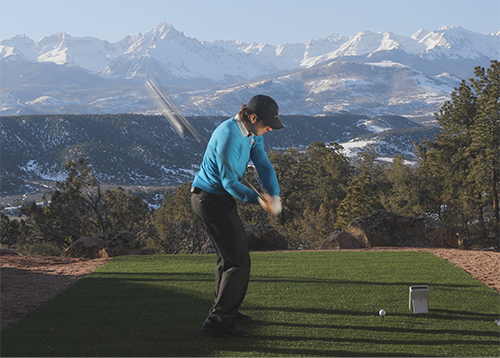Jordan Spieth - Fairway Wood Consistency
Jordan Spieth - Fairway Wood Consistency
Description
In this video, I'll show you the key areas in Jordan's swing that allow him to hit his fairway woods nice and solid every single time. I'll also show you how important axis tilt is at address and how important the lead shoulder position is at impact when hitting golf shots off those tricky tight lies. You will learn how to locate the mistakes in your own swing and get on your way to reaching those par 5's in 2.
Video Practice Points
- Make sure your spine is tilted just inside your lead knee at address.
- Weight distribution at address should be even after axis tilt is performed.
- Allow for secondary axis tilt in the hitting area only after you are fully shift to the lead side.
- Check to make sure the lead shoulder is not drastically higher at impact from where it was at address.

If you've found yourself struggling on the golf course, topping, chunking, or mishitting your fairway woods altogether, then you want to pay close attention to this week's analysis on Jordan Spieth. I'm going to show you how Jordan uses two very key moves in his golf swing in order to hit his fairway woods really solid. Let's go ahead and get started. Okay, so this past weekend, Jordan Spieth fires a final round 63 at the Australian Open, blowing the field away by six shots, so congratulations to Jordan Spieth on that. And just to kind of put in perspective of what kind of round he had, there was kind of a funny Twitter message yesterday that Rory McIlroy put out and said you could give Rory 100 rounds on that golf course, in those playing conditions, and no way he would have ever touched 63. So that just kind of shows you how great of a round that he had, so congratulations to Jordan on that. And this week, we're going to focus in on a really important area of the game, and that's going to be fairway woods.
I know a lot of us at home struggle with, when we get onto a par 5, or we get on these tighter lies, we're either trying to hit a 3-wood, or a 5-wood or a hybrid, where we either top it down the fairway, or we chunk it, or we bounce the club off the ground into the ball, and we find ourselves getting really frustrated and trying to figure out why this is happening. And I want to show you some of the things that he does in his golf swing well, and I also want to talk to you about what you're going to be able to do to help correct yourself with some of the issues that you may be having, and what you need to be able to look for as far as self-analyzing, and get you back on track to playing some really good fairway wood golf. All right, so some of the areas that we'll focus on this week, we're going to talk about the lead shoulder, talk about ... I'll mark that position for us.
Also going to mark the position of the spine here at address, and this is what we call axis tilt. Now, axis tilt is probably one of the most overlooked features of the setup, but is one of the most critical areas of the setup for a number of reasons. It allows us to get the head in behind the golf ball, so you'll notice here that he's got, ball position is perfectly placed right off that left ear, all right? This is a perfect ball position right here, and it also allows us to stay evenly distributed, so axis tilt, if you've noticed that you feel either preloaded into your lead side or you feel too much weight into your trail side, double check to make sure that you have axis tilt down correctly. Also, the important of axis tilt is, is that if you don't set up enough of the ... Of axis tilt, excuse me. If you set up with your spine more vertical, then you can run the risk of either over-rotating the spine, or, from a fault fix perspective, you can start to run into a reverse pivot.
And at the top part of your golf swing, if you notice that your spine is leaning more towards the target, that can do two things. It can compress your lower vertebrae, and it can also run you into that reverse pivot that I just said. When you reverse pivot and you're now leaning more over your lead side, then in the downward move, as a compensation, you're going to fall back on your trail side, which can, this is where you'll start to hang back. You'll bounce the club off the ground, or you'll create this really drastic ascending blow, where you'll hit a lot of top shots. So what we're going to be looking for here is, number one, we want to make sure that we feel evenly distributed at address position with proper axis tilt. All right, like I said, I've marked two really important positions here, as far as the head position's concerned, and I marked where the lead shoulder is.
You're going to see, let's go ahead and load up to the top. So we've shifted to the right, big load up to the right side, big rotation. Notice the straight line up from the lead side all the way through the spine. You don't see the spine leaning more towards the target. This is a very, very good spot for you guys to really understand. Also, notice that the head has not moved too far off the golf ball. Now, the reason why I'm talking about this straight line up from the lead side is, if you've noticed any big curvature to your lead leg here, you don't have this straight line up, or if you've noticed that the spine is now leaning more towards the target, that's where you're going to need to start to correct your rotation process.
And I would double check to make sure you have axis tilt down properly, because from the address position, when we shift our pelvis just a fraction to get that weight started over to that trail side, you actually lose a little bit of that tilt, so that's why it's really important that we have the spine just inside the left knee at address. Now, you're going to see a couple of big moves here, so you'll see, in downswing transition, you're going to see a pretty good-sized shift left, so this is where the head position starts to shift back in front of where it was originally at address. So you can see how he's shifting his hips. He's unloading the lower body, getting everything fully seated over the left side, so now his head is a good two, two and a half inches in front of where it was at the starting point, and this is where he's going to start to really push that left heel into the ground, and he's going to start to pull that left hip away from the target, which is, in turn, he's creating torso rotation.
Now, you'll hear that term around the website, you'll hear secondary axis tilt. Now, this rotation alone that he's causing, or that he's using, is creating the secondary axis tilt, which is going to be really pivotal for us to be able to shallow the arc out properly, but we have to be able to be fully seated into that lead side before we start to make this rotation to get things shallowed out. So watch the head position here. It does not move any more forward when he gets shifted over to that lead side, and now he's going to start to use that lead side to start to pull and rotate, and now you're going to see the head start to move back into its original starting point, so let me go one more frame here for us. All right, so here we are at impact. So notice the head position is back right where it was at the starting point, and notice the lead shoulder right here, okay?
So this lead shoulder is not way up above where it was at the address position, so these two things right here, these two areas you want to watch out for, and these are probably the culprits or the reasons why you've been having a hard time hitting solid golf shots. So if you've noticed that your head is out in front of this line, now, chances are, we call that being out in front of the golf shot. That can cause the angle of attack to become very steep, and if you become very steep with these fairway woods, you can either create a ton of backspin to where you'll get a lot of ballooning to your golf shot, or you can actually, you have this really descending blow where you'll hit the top part of the ball or down into the ground, and you'll hit this really big, bad top shot, or you can actually hit the ball down into the ground. I've seen that happen before.
All right, so if you've noticed that your head position's out in front here, chances are you have not used, yourself, or used the ability to create what we call secondary axis tilt to help shallow things back out. Club is going to be very steep coming into the ground. So when I talk about secondary axis tilt, you can see now that the spine is facing just outside the lead knee here from where it was at address, so it was just inside at, from an evenly weight-distributed, address position to now being fully seated left and then being able to create a little bit of torso rotation, of pulling that lead hip away from the target, and now he's allowed things to shallow out properly. Also, if you've noticed that your lead shoulder is above this line quite a bit, okay? If you've noticed that it's two, three inches above where you were at address, then probably you have created way too much secondary axis tilt.
And when you create too much secondary axis tilt, that can cause you to hang back on your trail side, so when you get hung back there, that's where you're going to run into the problem where you'll either shallow things out too much and the club's going to bounce off the ground, or you'll go create that really ascending blow and you'll just top it. So those are the two areas that you really need to focus in on your golf swing, is making sure that you understand where your head position is at address, where it is at impact, and then, also, where your lead shoulder is. If your lead shoulder, like I said, is way above, then you need to focus on making sure that you get rid of a lot of that secondary axis tilt, and that'll help you get back into hitting golf shots more solidly. So there are some good drills on the website. There are some great videos. We have the hip bump axis tilt video that's in the program setup section. We also have "The Importance of Axis Tilt," and that's a video that's in the advanced section.
I'm going to put these videos over to the right-hand side of the player, talk about, it'll be the recommended videos for this week. Also, another great video on the website I think is often overlooked is the level shoulders drill. That's a great video that Chuck talks about how to get the shoulders more level in the hitting area. But make sure that if you're going to work on that drill that you don't have your head moving way too far out in front of this line, because that can create that mess of problems with either coming in too steep or hitting some top shots as well. All right, guys, so these are the key areas I want you to check out in your golf swing. Make sure that you have great axis tilt and setup. Make sure that you rotate around your axis properly. Make sure, in downswing transition, that you shallow things out properly.
After you get fully seated left and you're creating proper rotation and the proper secondary axis tilt, make sure that that lead shoulder's not getting way up in the air, and get on, you're well on your way to hitting some great fairway woods and not embarrassing yourself on the golf course any longer. All right, look forward to working more with you guys in the future. Now let's get out there and hit some great shots and make it a great day.
Testimonials

-Dr. Jeffrey Broker, Assoc. Prof. in Biomechanics at University of Colorado at Colorado Springs and Former Senior Biomechanist for U.S. Olympics Committee

-Hub Orr - Happy PREMIUM MEMBER of RotarySwing.com

-Sam Jarman, PGA Golf Instructor in the UK

Build the perfect golf swing following the most advanced online golf swing learning system!
JOIN OUR 445,148 MEMBERS AND GET INSTANT FREE ACCESS TO DOZENS OF VIDEOS!



